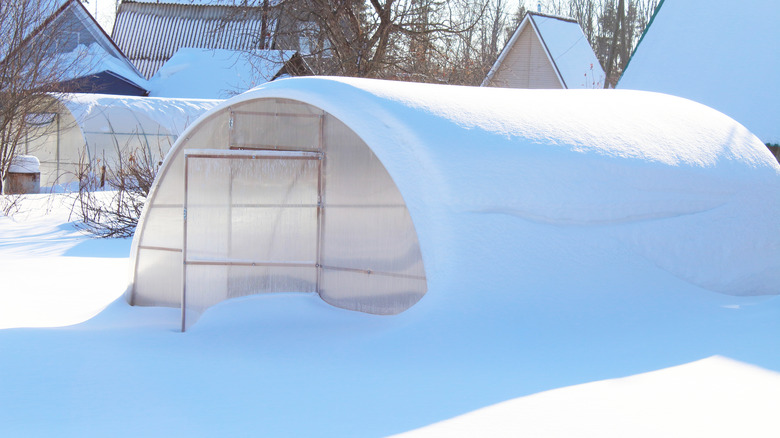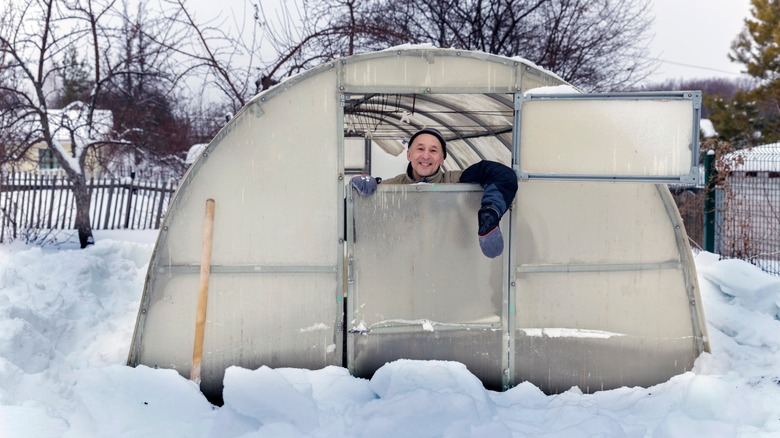Keep Your Garden Soil From Freezing This Winter With TikTok's Clever Hoop House
If you've thought about building a greenhouse, you have probably considered using it to stretch the growing season where you live. And it works, extending harvests a few weeks later in the fall and adding a days, or a weeks (depending on what you're growing), to the front-end of spring. But we're usually disappointed to find that a simple greenhouse with a single layer of plastic is all but impossible to keep warm over the coldest of long winter nights. The expense and effort of greenhouse construction might not seem worth it. TikTok gardener, Dagny Kream (@thecottagepeach), has discovered a construction method that makes it a snap to set up a hoop house, and she believes that adding additional layers of plastic can keep her gardening even when temperatures drop very low (0-20 degrees Fahrenheit in her area), which is one of the main advantages of growing plants in a greenhouse.
Her sturdy, super-simple hoop house design gets its strength from a stiff bit of fencing called a cattle panel. The welded wire panels are 16 feet long, usually 48-50 inches wide, and cost $28-33 each at Tractor Supply. That means you can put up a hoop house structure that's 5 feet wide and just over 7 feet tall by simply bending the panels over to form an arch. For her 12-foot-long hoop house, Kream used 6 millimeter UV-stabilized greenhouse plastic atop three panels, supported at their ends by boards held in place with rebar driven into the ground.
Getting the right hoop house temperature
Kream echoes a claim by greenhouse guru Eliot Coleman that with each layer of greenhouse covering, inside you'll get a climate equivalent to a 500-mile move south (via "The Four Season Farm Gardener's Cookbook"). To realize this kind of benefit, you might need a heat source and you definitely need a focus on cold-loving plants. But in some areas, you can come pretty close to a 12-month growing season with a hoop house. One key is to increase the insulation power of the walls with a second layer of plastic, separated from the first by air from a small blower. This improves the walls' R-value (unit of thermal resistance) of .85 for a single layer to 1.25, which means you can use a heat source with as much as 40% less output to reach the same temperature.
Using row covers inside greenhouses, which Kream promotes in a YouTube video, does a great job of protecting the plants within because the greenhouse structure blocks winds. These fabric floating row covers are the best material to protect your plants from frost, and even use condensation and ice on the cloth to trap heat inside. John Biernbaum of Michigan State University says temperatures under greenhouse row covers can stay at 12-15 degrees Fahrenheit while outside temperatures reach as low as -20 degrees Fahrenheit. If you're intent on a long growing season, three layers (two inflated greenhouse plastic layers and row covers inside) are the way to go.
Handling low winter light in your greenhouse
Temperature is only half the story. As Kream suggests, you also have to keep an eye on how much light makes its way to your plants, and how long it's available. According to Biernbaum, because of shorter daylight hours and lower light intensity in winter, you can get 20x as much light on a sunny June day as on an overcast January day. In southern climates, this lower winter intensity level is still sufficient for many plants, but in more northern areas, there might be too little light for plant growth. Since crops only get around 60-75% of this light inside a double-walled hoop house, you have to factor that in. One way to ease this problem is by spacing your plants out more so they don't block each other's light.
It's best to focus on winter crops with lower light requirements, like leafy greens, beets, carrots, and broccoli. Use clear greenhouse plastic, and keep in mind that older plastic and UV stabilization will both reduce the light that reaches your plants. You can measure your light intensity with specialized equipment, or simply keep tabs on your plants' growing habits. Watch for plants that are growing very slowly or not at all. If you see slow growth or unusually leggy plants, you might be having a light problem.

